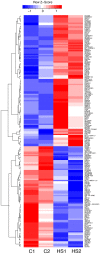Heat shock alters the expression of schizophrenia and autism candidate genes in an induced pluripotent stem cell model of the human telencephalon
- PMID: 24736721
- PMCID: PMC3988108
- DOI: 10.1371/journal.pone.0094968
Heat shock alters the expression of schizophrenia and autism candidate genes in an induced pluripotent stem cell model of the human telencephalon
Abstract
Schizophrenia (SZ) and autism spectrum disorders (ASD) are highly heritable neuropsychiatric disorders, although environmental factors, such as maternal immune activation (MIA), play a role as well. Cytokines mediate the effects of MIA on neurogenesis and behavior in animal models. However, MIA stimulators can also induce a febrile reaction, which could have independent effects on neurogenesis through heat shock (HS)-regulated cellular stress pathways. However, this has not been well-studied. To help understand the role of fever in MIA, we used a recently described model of human brain development in which induced pluripotent stem cells (iPSCs) differentiate into 3-dimensional neuronal aggregates that resemble a first trimester telencephalon. RNA-seq was carried out on aggregates that were heat shocked at 39°C for 24 hours, along with their control partners maintained at 37°C. 186 genes showed significant differences in expression following HS (p<0.05), including known HS-inducible genes, as expected, as well as those coding for NGFR and a number of SZ and ASD candidates, including SMARCA2, DPP10, ARNT2, AHI1 and ZNF804A. The degree to which the expression of these genes decrease or increase during HS is similar to that found in copy loss and copy gain copy number variants (CNVs), although the effects of HS are likely to be transient. The dramatic effect on the expression of some SZ and ASD genes places HS, and perhaps other cellular stressors, into a common conceptual framework with disease-causing genetic variants. The findings also suggest that some candidate genes that are assumed to have a relatively limited impact on SZ and ASD pathogenesis based on a small number of positive genetic findings, such as SMARCA2 and ARNT2, may in fact have a much more substantial role in these disorders - as targets of common environmental stressors.
Conflict of interest statement
Figures




Similar articles
-
CRISPR/Cas9-mediated heterozygous knockout of the autism gene CHD8 and characterization of its transcriptional networks in cerebral organoids derived from iPS cells.Mol Autism. 2017 Mar 20;8:11. doi: 10.1186/s13229-017-0124-1. eCollection 2017. Mol Autism. 2017. PMID: 28321286 Free PMC article.
-
Integrative transcriptome network analysis of iPSC-derived neurons from schizophrenia and schizoaffective disorder patients with 22q11.2 deletion.BMC Syst Biol. 2016 Nov 15;10(1):105. doi: 10.1186/s12918-016-0366-0. BMC Syst Biol. 2016. PMID: 27846841 Free PMC article.
-
ZNF804A Transcriptional Networks in Differentiating Neurons Derived from Induced Pluripotent Stem Cells of Human Origin.PLoS One. 2015 Apr 23;10(4):e0124597. doi: 10.1371/journal.pone.0124597. eCollection 2015. PLoS One. 2015. PMID: 25905630 Free PMC article.
-
Modeling synaptogenesis in schizophrenia and autism using human iPSC derived neurons.Mol Cell Neurosci. 2016 Jun;73:52-62. doi: 10.1016/j.mcn.2015.12.002. Epub 2015 Dec 2. Mol Cell Neurosci. 2016. PMID: 26655799 Free PMC article. Review.
-
Recurrent rearrangements in synaptic and neurodevelopmental genes and shared biologic pathways in schizophrenia, autism, and mental retardation.Arch Gen Psychiatry. 2009 Sep;66(9):947-56. doi: 10.1001/archgenpsychiatry.2009.80. Arch Gen Psychiatry. 2009. PMID: 19736351 Free PMC article. Review.
Cited by
-
Target Genes of Autism Risk Loci in Brain Frontal Cortex.Front Genet. 2019 Aug 9;10:707. doi: 10.3389/fgene.2019.00707. eCollection 2019. Front Genet. 2019. PMID: 31447881 Free PMC article.
-
Individual Copy Number of Ribosomal Genes as a Factor of Mental Retardation and Autism Risk and Severity.Cells. 2019 Sep 26;8(10):1151. doi: 10.3390/cells8101151. Cells. 2019. PMID: 31561466 Free PMC article.
-
CRISPR/Cas9-mediated heterozygous knockout of the autism gene CHD8 and characterization of its transcriptional networks in neurodevelopment.Mol Autism. 2015 Oct 19;6:55. doi: 10.1186/s13229-015-0048-6. eCollection 2015. Mol Autism. 2015. PMID: 26491539 Free PMC article.
-
Reduced CYFIP1 in Human Neural Progenitors Results in Dysregulation of Schizophrenia and Epilepsy Gene Networks.PLoS One. 2016 Jan 29;11(1):e0148039. doi: 10.1371/journal.pone.0148039. eCollection 2016. PLoS One. 2016. PMID: 26824476 Free PMC article.
-
Investigation of Schizophrenia with Human Induced Pluripotent Stem Cells.Adv Neurobiol. 2020;25:155-206. doi: 10.1007/978-3-030-45493-7_6. Adv Neurobiol. 2020. PMID: 32578147 Free PMC article. Review.
References
-
- Ayalew M, Le-Niculescu H, Levey DF, Jain N, Changala B, et al. (2012) Convergent functional genomics of schizophrenia: From comprehensive understanding to genetic risk prediction. Mol Psychiatry 17: 887–905 10.1038/mp.2012.37 ; 10.1038/mp.2012.3710.1038/mp.2012.37; 10.1038/mp.2012.37 - DOI - DOI - PMC - PubMed
Publication types
MeSH terms
Grants and funding
LinkOut - more resources
Full Text Sources
Other Literature Sources
Medical
Molecular Biology Databases

